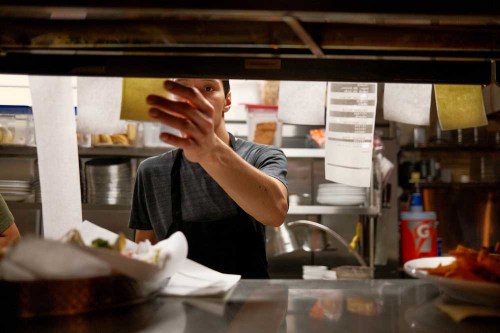Help wanted: Eastern Oregon feels pinch of labor shortage
Published 5:00 am Tuesday, July 20, 2021

- Head chef Trevor Olson looks through the line of orders June 26, 2021, during his shift at Nookie’s Restaurant & Brewery in Hermiston. Many businesses in Eastern Oregon are looking for workers, but the restaurant industry is the most visible indication of the labor shortage, with many kitchens having overworked staff pushed to their limits.
LA GRANDE — The Oregon Employment Department has reported the number of residents in Eastern Oregon receiving unemployment benefits is lower now than it was before the pandemic started.
That statistic makes no difference to the lines of orders filing through the printer at Nookie’s Restaurant & Brewery in Hermiston, which has struggled to find workers as the nation faces a new complication in the economic recovery from the pandemic.
“I don’t have a single cook that’s not in overtime right now,” said Trevor Olson, the head chef at the restaurant and brewery.
He’s been a cook for nearly seven years, shifting around other restaurants in Hermiston and Tri-Cities before coming back to Nookie’s last winter. At 25, Olson is in charge of the entire kitchen at the eatery.
“Halibut in 30 seconds,” Olson said down the line.
The two prep cooks were busy at the stove as flames licked at the pans cooking seafood alfredo. Neither are older than 20.
Olson flipped two burgers, flames reached toward the ceiling. The previous head cook quit some time after Umatilla County relaxed its restrictions due to dropping COVID-19 cases in May 2021, leaving Olson and sous chef Lupe Delgado to run the restaurant.
Before his shift started that day, Olson had already clocked 60 hours for the week.
In John Day, nearly every business in the town is struggling to fill positions.
“My crew is having to work seven days, long hours, because we’re so short staffed. A couple weeks ago we had to close down just to give people a day off,” said Heather Rookstool, a manager at Outpost Pizza Pub & Grill in John Day.
Shawn Duncan, owner of Squeeze-in Restaurant & Deck in John Day, is in the same situation.
“I had been closing early because I couldn’t get anyone, and the ones I do have, have been working their butts off,” Duncan said. “It’s been hard.”
Duncan said finding workers is a hurdle for almost every restaurant and business in John Day, and shop windows throughout town display “Help Wanted” signs.
Addressing the elephant
Most restaurant owners point to supplemental unemployment benefits as not only a principal cause of the labor shortage but also a cause of lowered morale among employees. However, record-low unemployment rates in states such as Nebraska, Idaho and Utah — which are at or below their pre-pandemic levels — has done little to stave off their own labor shortage problems.
The continued benefits, which are set to last until Sept. 6, prompted Eastern Oregon leaders and officials to send a letter to Gov. Kate Brown on June 7 demanding the end of the federal supplement to the 1,468 unemployed workers collecting benefits in Eastern Oregon.
The shortage has also prompted employers to offer increased benefits, signing bonuses and higher wages to entice workers back. In La Grande, the McDonald’s restaurant on Island Avenue for months had a banner advertising up to $14 an hour to new employees. That later increased to $15.
“When our McDonald’s is paying $15 and needs workers, our unemployment should be zero percent,” said Matt Scarfo, a Union County commissioner and business owner in La Grande.
But ending those benefits, according to economists, would not fix the economy’s woes.
Scott McConnell is an economics professor at Eastern Oregon University and also runs Side A Brewing in La Grande, which has given him close-up experience with the labor shortage.
“The research says no,” said McConnell regarding whether ending expanded unemployment benefits would resolve the labor shortage. “I think it’s easy to point at that as being the sole reason.”
A large portion of the workforce has returned to the labor market, McConnell said, adding, “These people were all making benefits — these people all made that decision to go away from benefits and get back in the (labor) market.”
But it is the ones who haven’t returned that confound economists and state leaders alike.
“This last group of people,” McConnell said, “what do we do for them?”
What happened to the workforce?
Across the region, unemployment claims are lower than their pre-pandemic levels in February 2020, before government shutdowns halted the economy. The Oregon Employment Department reported unemployment claims for Eastern Oregon for May 2021 was 1,468. In February 2020, before the pandemic, that number was 1,605.
Only 136 of those claims come from unemployed service industry workers — representing 9.26% of those receiving benefits. For Union County, that number of claimants was 19, while Umatilla and Baker counties had 56 and 19, respectively. The majority of continued claims, from all Eastern Oregon counties, came from the construction, agriculture and production industries.
According to Oregon Employment Department data, the leisure and hospitality industry saw a significant chunk of workers leave the field altogether over the course of the pandemic. Many, it seems, were able to find work in their professional careers — ones that matched their college degrees or training.
“I did have a few employees who have degrees and (the pandemic) actually gave them time to go look for better jobs that would fit their degrees instead,” Scarfo said.
That economic theory is backed up anecdotally. The Oregon Restaurant & Lodging Association polled a number of restaurants across the state. Out of the dozens of responses that were published, approximately 20% mentioned employees not returning because they had found or were looking for a career change.
“There were a number of individuals who switched industries during the early part of the pandemic when it became clear it was a crisis that was not going to resolve quickly,” wrote Cari Shafer, of Oxford Suites in Pendleton, to the restaurant association on March 17, 2021.
Other factors
“There’s not just one thing going on right now,” said Chris Rich, the state’s regional economist for Eastern Oregon. “There’s a bunch of different pieces that contribute to what we would really term more of a tight labor market than a labor shortage.”
One of those factors has been a problem in Oregon for several years.
“The big one that everyone points to right now is actually child care,” McConnell said. “They’ve had a lot of closures of child care places permanently. It’s not so easy to take an economy, shut it down and then just expect it to wake back up.”
A January 2019 report from Oregon State University found much of Oregon remains a child care desert, meaning there were three children for every available slot at child care centers.
According to a report from the Oregon Employment Department, nearly 40% of the Oregon labor force has children at home, and with the inability to find adequate child care, that has left 17%, or roughly 350,000 workers, in a bind.
Lack of housing is another problem. La Grande High School Assistant Principal Eric Freeman recently said the school lined up a prospective teacher to fill the school’s ranks, but the applicant turned down the offer after failing to find housing.
In Union County, websites on Thursday, July 8, listed just three vacancies for apartments and only 10 available homes for sale through local Realtors, with an average price of $217,620.
The housing market was fiercely competitive before the pandemic, with prospective buyers clamoring for available properties, which drove up the prices considerably. This was also a reality in rural areas where populations aren’t growing. For example, Grant County saw a population decrease of 1.7% from 2010 to 2020, according to a June 4 report from the Oregon Employment Department, but housing prices increased in the county by 53.3% from 2019-2020, reported a February story in the Blue Mountain Eagle.
With the pandemic waning, the market seems to be worsening for buyers as well as renters. A July 8 online search for apartment and housing rentals in Grant County came up dry, with zero results, and the Blue Mountain Eagle classified page showed only two homes for rent.
Besides housing, enrollment at La Grande’s Eastern Oregon University was down by nearly 150 students last year — and consequently, so was the pool of students local restaurants such as Nell’s-N-Out often pulled from.
“One of the first things that affected me was that I had no college people applying,” said Traci Hoadley, the owner of Nell’s-N-Out in La Grande. “I normally employ at least 30% to 35% of my staff as college students. When it came time to hire, I normally have a very generous resume pool, but I had none.”
Some economists say that labor shortages are simply wage shortages. This led Mitch Meyers, owner of Nookie’s, to offer generous incentives to prospective employees.
“I’m having to pay a $1,000 hiring bonus to 17-year-old kids, who don’t even have a driver’s license, with no work experience, and paying $18.50 an hour,” he said. “And you know what happens? You hire them, they work one day and quit.”
Structural changes
McConnell said he believes the pandemic caused a great structural shift in the economy that pulled workers out of the labor force entirely, though data on this remains scarce.
“My hunch is that the majority of (those who are unemployed) have structural adjustment issues,” said McConnell, “such as child care availability. Many of them may also be unwilling to lose Medicare benefits. By moving back into the workforce, they will lose access to care. This economic crisis is highlighted by the significant lack of affordable health coverage in the economic system right now.”
McConnell also said the federal unemployment benefits kicker amounts to $2.7 million in Union County alone between July 1 and Sept. 6, when the benefits are expected to end. But ending them early, he said, would be a mistake.
“You may add more incentive to look for work,” he said. “But in the meantime, you’re actually going to take a lot of money out of the system, which may actually depress the economy.”






